
|
NAPOLEON I: (1769-1821) Emperor of France 1804-14, 1815. A very interesting content L.S., ‘Napoleon’, an excellent and in full bold ink signature example, one page, 4to, Paris, 13th March 1808, to Eugene de Beauharnais, in French. A short letter containing very interesting political strategy decisions by Napoleon, addressed to his stepson Beauharnais who, at the time of the present letter, was Viceroy of Italy, stating ‘My son, we must leave in Rome the Neapolitan workers and the monks, provided that they behave well. Cardinals and the main Lords are the ones who must return to Naples.’ and further saying ‘We must treat well the former King of Sardinia who has truly renounced to all affairs and we must reassure him in order to remove all his concerns.’ Extremely small overall age wear with left edge very slightly irregular, otherwise VG £1000 - 1500 €1100 - 1700
Eugene de Beauharnais (1781-1824) French Prince, son of Josephine de Beauharnais, Viceroy of Italy 1805-14 and Grand Duke of Frankfurt. Stepson and adopted child of Napoleon Bonaparte.
Napoleon most probably refers to Charles Emmanuel IV (1751-1819) as the former King of Sardinia from 1796-1802.
|
|

|
ISABEY JEAN-BAPTISTE: (1767-1855) French Painter. Isabey was patronized by Napoleon Bonaparte and Josephine and was in charge of their ceremony of coronation. D.S., ‘Isabey’, one page, large folio, Paris, 16th December 1808, in French. The partially printed document refers to the expenses approved for works requested for the spectacles at the Tuileries theatre and is signed by Isabey in his capacity as painter and artist in charge of the theatres of his Majesty the Emperor and King at the service of the Grand Chamberlain. Showing two countersignatures at the base of the document. With blank integral leaf bearing a Vander Ley watermark. Folded. VG £100 - 150 €110 - 170
‘..make sure they are ready for immediate response..’
|
|
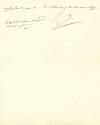 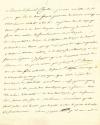 |
NAPOLEON I: (1769-1821) Emperor of France 1804-14, 1815. An excellent L.S., Np, two pages, 4to, Ebersdorf, Austria, 20th May 1809, to General Clarke, in French. An interesting military letter, in the hand of Meneval, addressed by the Emperor to the Minister of war and written the day before the Battle of Aspern-Essling. Napoleon reports having received his correspondent’s letter and instructs him to adjust the number of men assigned to the half-brigades, explaining the military importance of such regiments, and further stating in part ‘You were wrong ordering the Reserve Dragons regiment of Versailles to move to Hanau, …better order them to head to Strasbourg were regiments are being formed… plus what is available at the Camp of Boulogne, in order to gather at Ghent the demi-brigades from Ghent, Maastricht,..’ Napoleon further refers to the half-brigades of Paris, the number of men required and instructing ‘..make sure they are ready for immediate response to send them to all coast positions we will indicate.’ Receipt of the letter annotated in another hand at the conclusion, dated 26th May. A letter of interesting content. VG £1200 - 1500 €1400 - 1700
Henri Jacques Guillaume Clarke (1765-1818) Marshal of France in 1816, one of six created under King Louis XVIII from 1815-24. Duc de Feltre and Minister of War under Napoleon.
Claude François de Méneval (1778-1850) Baron of the Empire. Memoirist of the 19th century. Napoleon’s private secretary and his closest collaborator.
At the Battle of Aspern-Essling (21st-22nd May 1809) Napoleon was for the first time personally defeated, although he could withdraw most of his troops.
The demi-brigades, or half-brigades were military formations used by the French army since the French Revolutionary wars. The Demi-brigade amalgamated the infantry organizations into a single unit.
|
|

|
[HOUSE OF EMPEROR - MARIE LOUISE]: A curious document issued by the Grand Chamberlain, at the service of the Emperor and King’s House, one page, folio, Paris, 10th October 1810, in French. The partially printed document reports Napoleon’s order related to the new Empress Marie-Louise, who would become Empress Consort in April 1810, and to her six Ladies-in-waiting. The Emperor approves an allocation of 3000 francs, a very high amount at that time, for ‘According to the Emperor and King’s decision.. His Majesty has granted three thousand francs to each of the six first ladies-in waiting of the Empress…Mad. Boisbrulé, Mad. Durant, Mad. Balant, Mad. Mallerot, Mad. Rabusson, etc..’, Madame Durant being the widow of General Durant. VG £100 - 120 €110 - 140
|
|

|
DUPUYTREN GUILLAUME : (1777-1835) Baron Dupuytren. French military Surgeon. Best known for his description of the Dupuytren’s contracture which is named after him. A brilliant Teacher and a gifted Surgeon who leaded important contributions to medicine and surgery. L.S., ‘Dupuytren’, one page, 4to, Paris, 4th December 1812, to Louis Joseph Aamon, in French. Dupuytren issues a certificate for ‘..surgery student under my supervision during the 1811 scholarship..’ With a blind embossed seal to the left border. Small overall,minor age wear. G £150 - 200 €170 - 230
A letter of historical interest, dictated by Napoleon to Baron Edouard Mounier,
written a month after returning from Russian campaign.
Once the siege of Danzig and the siege of Thorn are raised and my communications are restored… I will.. cross the Niemen around August 15th. It is the best period.. and two and a half months are enough for me to march on Vitebsk and the Dnieper area.. corps will be raised to 60,000 men, which will allow at the same time to enter Volhynia…
|
|
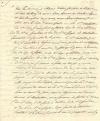 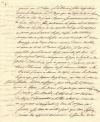 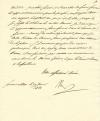 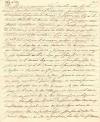 |
NAPOLEON I: (1769-1821) Emperor of France 1804-14, 1815. A very rare and exceptional L.S., Nap, nine pages with gilt edges, 4to, Fontainebleau, 27th January 1813, to Eugene de Beauharnais, in French. A letter of historical interest, dictated by Napoleon to Baron Edouard Mounier, written a month after returning from Russian campaign and only one day after receiving Murat at Fontainebleau and accusing him of having abandoned his army. Napoleon lengthly reports about his intentions to reorganize his armies, refers to many of his Marshals and reveals his intention to return to Russia, and begins his letter saying ‘My son, I do not have yet a precise idea in mind regarding the way the army has to be re-organized..’ and continues referring to regiments in Danzig, to troops under General Grenier, to General Lagrange ‘I asked you to replace General Lagrange, he cannot participate in such a war with an arm missing..’, to Marshal Ney ‘These three divisions will be commanded by the Duke of Elchingen and will keep the name of 11th Corps or take the name of Avant-Garde Corps of the Grande Armée… and this way you will have 6000 horses in the Avant-Garde Corps.’ Napoleon continues sending instructions regarding the reorganization of most of his Corps, Regiments and Battalions, establishing schedules and referring to many of his Generals, further saying ‘The Elbe Observation Corps (which will get a number), the Observation Corps of Italy, the 1st and 2nd Rhine Observation Corps.. the combined 2nd and 3rd Corps will have four divisions and forty-eight battalions each; the 4th Corps will have three divisions and thirty-six battalions. The total forces of the army beyond the Rhine by the end of June, the Danzig garrison excepted, will include thirty infantry divisions and three hundred and sixty-two battalions. Bringing up the number of men with weapons in each battalion to 650 and to a total amount of more than 200.000 infantry soldiers, and to over 300.000 French including cavalry, artillery and engineers. The Westphalian Corps will be raised… The Saxon, Württemberg and Bavarian Corps will have their ranks filled again. The army will thus be one third stronger than it was during the last campaign. Those various corps may be commanded as follows: 11th Corps, Duke of Elchingen; Elbe Observation Corps, Count Lauriston; Observation Corps of Italy, Count Bertrand; 1st Rhine Observation Corps, Duke of Ragusa or Count of Lobau; 2nd Rhine Observation Corps, Count of Lobau or Duke of Ragusa; 1st Corps, Prince of Eckmühl; combined 2nd and 3rd Corps, Duke of Reggio; 4th Corps, Duke of Taranto.’ Napoleon further confirms his plan, unknown till then, to return to Russia towards August 15th ‘Supposing Danzig is occupied.. the siege can only begin in April. I will thus have the entire month of June to march on Danzig. Once the siege of Danzig and the siege of Thorn are raised and my communications are restored… I will postpone moving any further until a future campaign or, if appropriate, cross the Niemen around August 15th. It is the best period since the harvest is over at that time, the fodder for horses is ripe and two and a half months are enough for me to march on Vitebsk and the Dnieper area.. corps will be raised to 60,000 men, which will allow at the same time to enter Volhynia… On top of this I will have 120,000 men in France and Italy to defend my coasts and borders.’ Further again referring with strong interest to Warsaw and Russia ‘I suppose you have summoned back all Cavalry regiments which were in Warsaw. Warsaw must be kept whatever it costs. Austria is rearming. And according to all available information Russia is in a terrible situation and can only send some small light cavalry towards Posen... It is thus necessary to remain in Posen to protect Warsaw and maintain communications.. Russia cannot leave less than 50,000 men in front of Danzig, 10,000 in front of Thorn, just as many in front of Modlin and less than 60,000 facing Galicia. Consequently, it is not possible that the Russian army starts marching towards you. The most important thing is to reorganize the cavalry corps of General La Tour-Maubourg in order to scout around and keep the enemy away from our communications.’ An unusual lengthy letter with extraordinary content. VGG £8000 - 12000 €9000 - 14000
Eugene de Beauharnais (1781-1824) French Prince, son of Josephine de Beauharnais, Viceroy of Italy 1805-14 and Grand Duke of Frankfurt. Stepson and adopted child of Napoleon Bonaparte.
Edouard Mounier (1783-1843) Baron of the Empire and cabinet secretary of Napoleon I. Became General Director of the French police in 1819.
Paul Grenier (1768-1827) French General during revolution and under the Empire, an excellent tactician credited with many battle victories.
Adelaide Blaise Le Lievre de la Grange (1766-1833) Marquis de la Grange et de Fourilles. French Cavalry General during the French Revolution and First Empire. De la Grange lost an arm in 1809 at the battle of Essling.
Duke of Elchingen (1769-1815) Michel Ney, French Marshal. Prince of the Moskowa. Executed.
Count Lauriston (1768-1828) Jacques Alexandre Law, Marquis of Lauriston. General in the French army and Diplomat of Scottish and Portuguese descent.
Count Bertrand (1773-1844) Henri Gratien Bertrand, French General, and Grand Marshal of the Palace. Bertrand was aide-de-camp to Napoleon I and the closest officer to the Emperor who had full confidence in him. He served during the expedition to Egypt and the Battles of Austerlitz, Wagram, Leipzig and Waterloo and accompanied Napoleon I to Elba in 1814 and to St. Helena in 1815. Bertrand was condemned to death in 1816 but did not return to France until Napoleon’s death when King Louis XVIII granted his amnesty. In 1840 Bertrand went to St. Helena to bring Napoleon’s remains to France.
Duke of Ragusa (1767-1847) Auguste Marmont, Nobleman and Marshal of France.
Count of Lobau (1770-1838) Georges Mouton, Marshal of France. During the Russian Campaign, he acted as a senior aide-de-camp to Emperor Napoleon. At the Battle of Waterloo he distinguished himself against the Prussians.
Prince of Eckmuhl (1770-1823) Louis Nicolas Davout, Duc d’Auerstaedt and Marshal of France. Known as the Iron Marshal. Davout was the only Napoleonic Marshal not to have been defeated in battle by 1815.
Duke of Reggio (1767-1847) Nicolas Oudinot, Marshal of France.
Duke of Taranto (1765-1840) Etienne Jacques Macdonald, Marshal of France.
The Siege of Danzig lasted from January to December 1813, and ended with the French surrender, and not as Napoleon was expecting he would be marching in Danzing in June as he says in the present letter. During the War of the Sixth Coalition the Russian and Prussian forces besieged the permanent French garrison, which had been augmented by soldiers from the Grande Armée retreating from its Russian Campaign. It was a major supply depot for Napoleon’s forces, with large quantities of food, munitions, forage, weapons, clothing and ammunition. Napoleon was trying to re-group an army in his rear in order to confront the Coalition, and so needed to guard the line of the Vistula by garrisoning Danzig, Thorn and Warsaw as he also explains in the present letter..
Niemen, Vitebsk, Dnieper and Volhynia are rivers and cities in Ukraine, Belarus, Poland, and are the key geographical locations Napoleon refers to when planning the return to Russia.
La Tour-Maubourg (1768-1850) Victor de Fay de La Tour-Maubourg. French Cavalry Commander. Minister of war 1819-21.
A copy of this letter was sent to the National Archives by Her Imperial Highness the Duchess of Leuchtenberg during the Second Empire. Duchess of Leuchtenberg was the wife of the second son of Eugène de Beauharnais and Princess Augusta Amalia Ludovika Georgia of Bavaria.
|
|
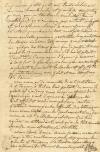 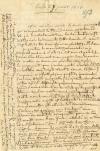 |
LARREY DOMINIQUE JEAN: (1766-1842) French Surgeon of Napoleon’s Grande Armée. Larrey was the Emperor’s favourite surgeon, an innovator in the battlefield medicine and widely considered one of the first modern military surgeons. Rare and extremely interesting lengthy A.L.S., ‘D.J. Larrey’, four pages, 8vo, Dresden, 7th July 1813, to his wife, in French. Larrey first reports on his recent conversation with the Emperor stating in part ‘I was waiting for the right moment to talk to H[is] M[ajesty] about this friend and for this reason I was keeping all the time the paper in my pocket. That morning at dawn…the Emperor asked me few graceful questions regarding my wounded soldiers with mutilated fingers, and I responded to all of them. Then he told me “Seems like you have had a great success as I have been told that they were all recovering”, Yes Sir, we have only lost a very small number. “That is good, I am satisfied”. Because Your Majesty is satisfied with my behaviour, would you allow me to ask for a favour? “Yes, What do you want?”..’ Larrey reports the full sentences exchanged with the Emperor, who finally had to refuse to Larrey’s request, further saying ‘..everybody was astonished, and were commenting the great influence I was having on the Emperor, because he gave to me many details and explanations regarding my request and the reasons for denying it..’ Larrey refers to the difficulty in finding the right moment and having the opportunity to talk to the Emperor, also saying ‘..in case the Emperor doesn’t change his mind, your sister and family should be happy as they have fortune, while we do not have a sol. I will not complain. I will have so many good souvenirs of my medical career, that as long as you have enough to live when I will die, that my soul will leave satisfied.’ Further on Larrey says ‘..Everything makes me fear a new war… I hope I will be able to see you before the 19th of November, because if I had to do another winter campaign I would for sure die. I hardly can warm up now.’ Before concluding Larrey refers to the news received from his friend Pelletan who is still at Wilna. A letter of very interesting content. Provenance, Crawford collection. Very small overall, minor age wear. VG £2000 - 3000 €2300 - 3400
Marie Elisabeth Laville-Leroux (1770-1842) French Painter and wife of Larrey. She was pupil of David, and used to sign her paintings “Larrey” when accompanying her husband during Napoleon’s campaigns.
Larrey was right when he writes “Everything makes me fear a new war”. Only a month later, 11th August, Austria would put an end to the armistice, and few weeks later took place the last major victory of Napoleon at the battle of Dresden.
Philippe Jean Pelletan (1747-1829) French Surgeon. One of Napoleon’s consultant-surgeon from 1804. Pelletan was present at the crime scene of Marat and signed the minutes on the death certificate and was also responsible of the controversial autopsy of the 10 years older Louis XVII, younger son of King Louis XVI and Marie Antoinette, both executed. It has been reported that during the autopsy, Pelletan was shocked to see the countless scars which covered the body of Louis XVII as a result of the physical abuse the child suffered while imprisoned in the Temple.
Napoleon would say about Larrey ‘If the army ever erects a monument to express its gratitude, it should do so in honour of Larrey.’
At Waterloo in 1815 his bravery under fire was noticed by the Duke of Wellington who saluted his courage and ordered not to fire in his direction so as to “give the brave man time to gather up the wounded”. When the battle was lost, Larrey was taken prisoner by the Prussians when he was trying to escape. They were about to execute him on the spot but was recognized by one of the German surgeons because he had saved the life of Blucher’s son when he was wounded and taken prisoner by the French. He was pardoned, invited as a guest to Blucher’s dinner table and authorized to go back to France with money and proper clothes.
‘..Our government had granted to Napoleon Bonaparte the privilege of taking with him to St. Helena three of his officers, twelve servants and his surgeon, and that I had been pointed out by Count Bertrand to replace the French surgeon..’
|
|
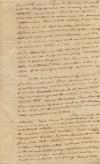 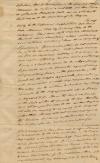 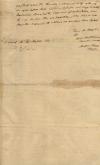 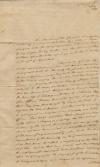 |
O’MEARA BARRY EDWARD: (1786-1836) Irish Surgeon who accompanied Napoleon to Saint Helena and became his physician. An excellent content A.L.S., ‘Barry O’Meara Surgeon’, seven pages, folio, Longwood, 5th May 1817, to Lieutenant Colonel Reade. A very lengthy and extremely interesting autograph letter in which O’Meara complaints about his equivocal situation in Saint Helena, accuses Lowe of not receiving him, and states in part ‘..Our government had granted to Napoleon Bonaparte the privilege of taking with him to St. Helena three of his officers, twelve servants and his surgeon, and that I had been pointed out by Count Bertrand to replace the French surgeon; but that not being willing to relinquish in my will my character of as a British officer I had made conditions that I should be placed on the list as a surgeon on full play and that I should be paid by the English government and consequently should not ever be considered as out of the protection of the laws of my own country…’ further clarifying ‘I am not subordinate to any other than the Governor, not in a military point of view or as a naval officer, but by a civil title and as surgeon to Napoleon Bonaparte.. I know well, Sir, that military obedience is passive and does not admit of hesitation or objection but it is not so with civil obedience and still less so in a person charged with an employment of so delicate nature as I am..’ O’Meara protests against the calumnies said about his person and threatens with denouncing in tribunals the tyrannical behaviour of Lowe, and states ‘For the due performance of my medical functions until now I have considered myself as not having any explanation to render except to Napoleon Bonaparte himself. He has never made any complaint against the manner in which I have fulfilled them. Indeed on the contrary, I have frequently been applauded by him... I made an open engagement to attend Napoleon Bonaparte…independent of all hatred or national prejudice.. I deny the intentions which you attribute to me of desiring to quit Longwood..’ and before concluding O’Meara warns ‘I have always considered that St. Helena is not a man of war, that the Governor is not the Captain and that I am not the surgeon of it, but that St. Helena is a government of one of our possessions, that sir Hudson Lowe is the Governor and commands by virtue of a civil title and that I form one of Napoleon Bonaparte’s suite.. His Excellency may perhaps reflects upon the terrible responsibility which weight upon him if (as possible and very probable) Napoleon Bonaparte, deprived of assistance, has to die before the expiration of the five or six months required to obtain an answer from England.’ Professionally repaired to the centre folds. G £3000 - 4000 €3400 - 4500
Hudson Lowe (1769-1844) Anglo-Irish Officer and colonial Administrator. Best known for his time as Governor of St. Helena as gaoler of Napoleon Bonaparte.
|
|

|
BERTRAND HENRI GATIEN: (1773-1844) French General. Count Bertrand and Grand Marshal of the Palace. Bertrand was aide-de-camp to Napoleon I and the closest officer to the Emperor who had full confidence in him. He served during the expedition to Egypt and the Battles of Austerlitz, Wagram, Leipzig and Waterloo and accompanied Napoleon I to Elba in 1814 and to St. Helena in 1815. Bertrand was condemned to death in 1816 but did not return to France until Napoleon’s death when King Louis XVIII granted his amnesty. In 1840 Bertrand went to St. Helena to bring Napoleon’s remains to France. A rare and interesting Autograph note by Bertrand, one page, oblong 8vo, [St. Helena], 1st of July 1817, to the Governor Sir Hudson Lowe, in French. Bertrand, in the third person and on behalf of Napoleon I states ‘The Count Bertrand is honoured sending his compliments to M. the Governor. He has received his letter from yesterday evening. The Emperor will receive today Admiral Malcolm and Admiral Plampin.’ A letter of interesting and historic content. VG £600 - 900 €680 - 1000
Hudson Lowe (1769-1844) Anglo-Irish Officer and colonial Administrator. Best known for his time as Governor of St. Helena as gaoler of Napoleon Bonaparte.
According to the St. Helena archives, Napoleon received Admiral Malcolm on July 2nd and Admiral Plampin on 3rd July 1817.
Sir Pulteney Malcolm (1768-1838) British naval officer. Malcolm was Commander of the Saint Helena station 1816-17, appointed to control the blockade of the island.
Robert Plampin (1762-1834) British Royal Navy Officer. In 1816 Plampin was appointed commander of the squadron at the Cape of Good Hope, which also had responsibility for Saint Helena. Plampin regularly visited and had numerous conversations with Napoleon.
Bertrand has been mentioned by Alexandre Dumas in his novel The Count of Monte Cristo, and by Victor Hugo in his novel Les Miserables.
‘..in the event of General Buonaparte’s death.. it is no longer necessary to enforce an observance… of the instructions originally given .. You will therefore in case of such an event no longer consider this instruction as in force, but will take measures for burying General Buonaparte
in St. Helena..’
|
|
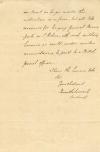 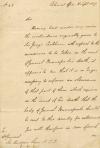 |
BATHURST HENRY - [NAPOLEON I]: (1762-1834) 3rd Earl Bathurst. Foreign Secretary and Secretary of State for War and the Colonies 1812-27, and President of the board of Trade. An extremely interesting historical letter with good association and excellent content. A.L.S., ‘Bathurst’, two pages, folio, Colonial Office, 18th September 1817, to General Sir Hudson Lowe H.C.B, at that time Governor of Saint Helena. Bathurst states ‘Having had under my review the instructions originally given to Sir Georg Cockburn with respect to the measures to be taken in the event of General Buonaparte’s death, it appears to me that it is no longer necessary to enforce an observance of that part of them which requires in the event of his death that the body of General Buonaparte should be sent to his Country for interment.’ and further sends the new instructions to the St. Helena Governor ‘You will therefore in case of such an event no longer consider this instruction as in force, but will take measures for burying General Buonaparte in St. Helena, with such military honours as would, under similar circumstances, be paid to a British General Officer.’ Bearing an attractive watermark. Accompanied by an A.L.S., by John R. Blakeney (1732-1832), two pages, 8vo, Longwood House, St. Helena, 7th February 1818, to Hudson Lowe. Blakeney refers to the day by day of the Emperor during that week, mentions the names of visitors, refers to general Bertrand, stating in part ‘Nothing extraordinary has occurred at Longwood.. on Sunday Gen.al Buonaparte dined with the family.. Gen.al Buonaparte was in the garden for about half an hour..’ Both letters with blank integral leaf and small professional repair to the inside centre fold. VG,2 £800 - 1200 €900 - 1400
Hudson Lowe (1769-1844) Anglo-Irish Officer and colonial Administrator. Best known for his time as Governor of St. Helena as gaoler of Napoleon Bonaparte. Lowe was appointed to the position of custodian of the Emperor of the French on 1st of August 1815. At the time of his appointment, Lord Bathurst, Secretary of State for War and Colonies wrote to Wellington “I do not believe we could have found a fitter person of his rank in the army willing to accept a situation of so much confinement, responsibility and exclusion from society.’
George Cockburn (1772-1853) British Admiral of the Royal Navy Fleet. He directed the capture and burning of Washington in 1814. Cockburn was in charge of conveying Napoleon I in August 1815 to Saint Helena, on board of HMS Northumberland. Cockburn remained until 1816 as Governor of the island.
|
|

|
PERCY PIERRE-FRANÇOIS: (1754-1825) French Doctor and Chief Surgeon of the Grande Armée during the Napoleonic wars. He invented a new kind of ambulance usable on battlefield. A good set of three documents, including an A.L.S., ‘Percy’, two pages, folio, , n.p., 10th July 1818, to Saucerotte, in French. Percy tells his correspondent that he is still waiting for his visit which he promised to his father and sends a request ‘..please make [a visit] to chevalier de Lormerie, who is staying under the Royal Palace arcades. This gentleman wishes very much to meet you and talk to you..’ further saying ‘..when you will see me going to university, something that happens daily, come to see me..’ Together with A.L., in the hand of Percy, one page, 4to, in French. Percy refers to the Asian progress in the medical field, stating in part ‘..They had the first kind of hospitals that were named Marastins. Rhazes was leading the Bagdad hospital, he explains having seen the biggest successes and also the most terrible errors…Most of the times doctors were Israelite, like Debou-Gazazi, Izaac..’, Also including an A.L.S., by Percy’s widow, one page, 8vo, Paris, 13th February 1828, to Vicount Morel de Vindé, in French. VG, 3 £200 - 300 €230 - 340
Victor-Joseph Saucerotte (1773-1845) Student of medicine at the time of the present letter. Son of Nicolas Saucerotte (1741-1841) Surgeon of the King of Poland.
Abu Bakr Mohammad Ibn Zakariya al-Razi (865-925) also known as Razi or Rhazes. Iranian Scholar who contributed to achieve important progress in the fields of medicine, alchemy and philosophy.
Charles-Gilbert Morel de Vindé (1759-1842) French literair and pair of France.
|
|

|
NAPOLEON I: (1769-1821) Emperor of France 1804-14, 1815. L.S., ‘Napol’, one page, 4to, Brienne, 1st of February 1814, to a Major General, in French. Napoleon states in part ‘Give the order that First Regiment of the Guard of Honour at Dreville join the divisions of France… let me know who are the Generals of Brigade assigned to the Guard of Honour. There should be 3 Colonels in this service, it’s more than what we need. I wish to choose one of them for the Guard service..’ Napoleon makes his last troops moves before the Six Days’ Campaign, the last battle victories of the French as the Six Coalition was approaching Paris. Two months later Napoleon abdicated, signed the Treaty of Fontainebleau, and went into exile to Elba. Overall staining, with folds, with small professional repair to the verso, otherwise G £1000 - 1500 €1100 - 1700
Only five and three days before the present document was signed Napoleon obtained two important victories defeating Blucher at Saint-Dizier (27th January 1814) and two days later at the Battle of Brienne (29th January 1814) where he surprised Blucher at his headquarters and nearly captured him, but on 1st of February, letter date, and 2nd, Napoleon is defeated by Blucher at La Rothiere.
| HISTORY
|
|

|
[CLUNY ABBEY]: Benedictine monastery in Cluny, France, dedicated to St. Peter. Its earliest basilica was the largest church one in the world until the St. Peter’s construction began in Rome. Rare 14th century parchment with an extremely attractive large wax seal, one page, oblong large folio, Cesena, 1358, given by Audrouin de la Roche, to Archbishop Petrignano, in Latin. De la Roche was a Benedictine abbot, who was in Cluny from 1351 to 1361, and who would be created Cardinal in Avignon by Pope Innocent VI. At the time of the present document, De la Roche was acting in his capacity as Apostolic Legate and General Governor of the Papal States in Italy. The document is an “Officium Capitaneatus” appointing several members of a diocese. Rare Cluny Abbey seal attached at the base of the document, in fine condition, showing a bishop figure and latin text around. Very carefully and neatly written with attractive calligraphy, and in very fine condition. VG £1500 - 2000 €1700 - 2300
In 1357 the Papal troops conquered the city of Cesena and in 1360 Abbot Audrouin participated in the Peace Treaty negotiations between France and England.
Royalty
|
|

|
CATHOLIC MONARCHS: ISABELLA I OF CASTILE (1451-1504) Queen of Castile 1474-1504 & FERDINAND II OF ARAGON (1452-1516) King of Aragon 1479-1516 & as Ferdinand V King of Castile 1475-1504. Known as the Catholic Monarchs, they ruled jointly over the Kingdoms of Castile, Leon, Aragon and Sicily 1475-1504. They are recognized for laying the foundations for the political unification of Spain, and also for completing the Reconquista as well as their support and financing of Christopher Columbus’ voyage of 1492 which led to the opening of the New World. Rare L.S., individually signed by the Queen and the King ‘Yo la Reyna’ and ‘Yo el Rey’, one page, oblong 4to, Zaragoza, 10th December 1433, to Juan de Ribera, in old Castilian. The document being a letter, sent by the King and Queen, to Juan de Ribera, Captain General in charge of our Kingdoms borders with Navarre, referring to their order related to ‘no people of our Kingdoms will cross the Kingdom of Navarre borders’ where at that time battles between “parcialidades y colores” were taken place. The King and Queen state having been informed that this order had not been fulfilled, they instruct Captain Juan de Ribera to ‘..make them all return to the towns they came from..’ The document bears a royal paper seal, detached from the verso, in very fine condition, and several countersignatures to the verso too. Folded. Extremely small age wear and few small stains, otherwise VG £4000 - 6000 €4500 - 6800
|
|
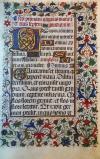 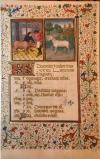 |
BOOK OF HOURS – ISABELA I: An excellent and very attractive book of hours, being a facsimile edition of “Breviario de los Laicos”, known as the Book of Hours of Isabela I, the Catholic Queen, a limited and exact reproduction of the original edition, issued in 1991. The book of hours contains 730 pages, 6 x 8, colour illuminated, very richly illustrated, in Latin. The original 15th century work, circa 1470, a jewel kept at the Royal Palace of Madrid, was a wedding present of the city of Zaragoza to Isabela I, the Catholic Queen. This book of hours is considered a sample masterpiece work of the Flemish miniature, including 3487 miniatures, 72 of them on full page. Attractively hand-bounded in blue leather with gilt overlay and handmade coated paper. The whole presented in an attractive blue velvet box. An awarded edition by the Culture Ministry. EX £1200 - 2000 €1400 - 2300
|
|

|
BOOK OF LAWS XVI CENTURY: An impressive 11 x 16 printed book, a very heavy copy of a Laws book, Tabula Legum Digesti Novi, hardback cover, containing over 870 pages, printed in two colours, black and red, with multiple small drawings, in Latin. The work is divided in chapters, ‘De Operis Novi Nuntiatione’, ‘De Donationibus’, ‘De Re Indicata’, ‘De Verborum Obligationibus’, being different legal matters such as (‘About Donations’, ‘About Word Commitment’, ‘About wills’), etc.. The book contains also some occasional ink hand written annotations to the borders in Latin. Overall age wear and some staining. FR £200 - 300 €230 - 340
|
|

|
BORJA Y ARAGON FRANCISCO DE: (1581-1658) Spanish Writer, an official in the court of King Philip III of Spain. Viceroy of Peru 1615-21. L.S., don Francisco de Borjas, one page, folio, n.p. (Lima?), 13th September 1616. The manuscript letter makes reference to slaves employed to work in the salt mines, who were taken from the owner, Juan de Villa, and orders that they be replaced, and further detailing the various regulations that they must work under. Boldly signed by Borja y Aragaon at the foot in his capacity as Viceroy of Peru. Some extremely minor, light age wear to the edges, otherwise VG. £80 - 100 €90 - 110
|
|

|
PHILIP III: (1578-1621) King of Spain 1598-1621. D.S., Yo el Rey, as King, a bold and large good youth signature example, one page, folio, Royal Palace of Valencia, 1st of February 1602, to Juan Alfonso Pimentel y de Herrera, Count of Benavente, Captain General of the Kingdom of Valencia, in Spanish and Valencian dialect. The King refers to a Royal Supreme Criminal Court decision regarding two sentenced prisonners accused of murder who were not given to the authorities as ordered, and requests the execution of the court decision. The document bears to the lower part of the document several countersignatures and to the verso a paper seal affixed. Folded, with several large tears to the folds and holes, affecting the text but none affecting the signature. Overall age wear. F £200 - 300 €230 - 340
|
|

|
FERDINAND VII: (1784-1833) King of Spain 1808, 1813-33. A.L.S., Fernando, one page, small 4to, Aranjuez, 28th April 1822, to Carlos Luis, his nephew, in Spanish. The King thanks his correspondent for his letter and explains ‘I have been in bed for ten days suffering from gout..’, he further refers to his third wife, Princess Maria Josepha Amalia of Saxony. With blank integral leaf. The letter bears a very attractive watermark featuring an image of King Louis XVIII of France and a coat of arms. Small hole to the blank leaf. Folded. VG £200 - 300 €230 - 340
Princess Maria Josepha Amalia of Saxony (1803-1829) Queen Consort of Spain 1819-29. The young Queen died in Aranjuez at the age of 25 as a result of fevers, leaving King Ferdinand heartbroken.
|
|

|
INFANTE JUAN OF SPAIN: (1913-1993) Juan of Bourbon, Count of Barcelona. Son and heir of King Alfonso XIII of Spain. Juan never acceded to the Spanish throne as his father was replaced by the second Spanish Republic. Under his son King Juan Carlos I, a constitutional monarchy was restored. Signed season’s greetings card by Juan of Bourbon and by his spouse Princess Maria de las Mercedes of Bourbon-Two-Sicilies and Orleans (1910-2000) Countess of Barcelona. The white stiff 8vo folding card featuring a photograph to the inside showing Juan and Maria de las Mercedes of Bourbon standing outdoors in a half length pose. Boldly and individually signed in Estoril, 1960, during his exile in Portugal. With two binder holes to the border, not affecting the signatures. G £60 - 90 €70 - 100
|
|

|
JUAN CARLOS I: (1938- ) King of Spain 1975-2014. D.S., J.Carlos Borbon R, one page, folio, Madrid, 6th March 2001, to President Hugo Banzer Suarez, in Spanish. On a partially printed document bearing at the heading a golden embossed Royal coat of arms, King Juan Carlos I informs President Banzer about the recent appointment of Victor Luis Fagilde Gonzalez as new Plenipotentiary Ambassador of Spain to the Republic of Bolivia. Signed by Juan Carlos I in bold blue ink. Countersigned by Josep Piqué. With a large blind embossed seal alongside the King’s signature. Two file holes to the left border not affecting the text or signature. An attractive document. EX £200 - 300 €230 - 340
Hugo Banzer Suarez (1926-2002) Bolivian military General and President of Bolivia 1971-78 as a Dictator, and 1997-2001 as constitutional President.
Josep Piqué Camps (1955- ) Spanish Foreign Affairs Minister 1996-2004.
|
|

|
CHARLES V: (1500-1558) Holy Roman Emperor 1519-56, and King Charles I of Spain 1516-56. Grandson of the Catholic Kings, Ferdinand & Isabella. He brought together such extensive territories in western, central and southern Europe, and the Spanish colonies in America and Asia. So large were his domains that they were described as ‘The Empire on which the sun never sets’. A good L.S., Yo el Rey, one page, large 12 x 14 folio, Plasencia, 13th September 1529, to ‘Holy Father’, in old Castilian. Writing in his capacity as King of Spain, King of Germany and of the Two Sicilies, King Charles I states in part ‘Our chaplain Don Alonso de Luzon has been troubled by a cantor of Your Sanctity about the school of psalms chants belonging to the Osma church which he guides for the last three years..’ Addressed to the verso. Charles V would be crowned Emperor by his correspondent, Pope Clement VII, only five months after the present letter date. Folded. Overall age wear, with few very small tears to the edges and minor holes only affecting few words, and not the signature. Small remnants of a former red wax seal. G £1000 - 1500 €1100 - 1700
Clement VII (1478-1534) Pope of the Roman Catholic Church 1523-34. Born Giulio de’ Medici. Clement VII was a statesman, a leader with bright and open mind, but lived a difficult Papacy between two powerful Kings, Holy Roman Emperor Charles V and Francis I of France, and forbidding the divorce of Henry VIII. Clement VII was imprisoned during the Sack of Rome, and after escaping confinement he compromised the Church and Italy’s independence by allying his former jailor Emperor Charles V, crowning him as Emperor in Bologna. Clement VII personally commissioned Michelangelo’s “The Last Judgement” for the Sistine Chapel, and Raphael’s “The Transfiguration”. He also personally approved Copernicus’ theory that the Earth revolves around the sun, 99 years after Galileo Galilei was sentenced in trial for heresy.
|
|

|
FERDINAND II: (1578-1637) Holy Roman Emperor 1619-37, King of Bohemia and Hungary. L.S., ‘Ferdinandus’, one page, folio, Graz, 10th December 1606, to Cardinal Alfonso Visconti, in Italian. Ferdinand, in his capacity as Archduke of Austria, thanks his correspondent for his help with Pope Paul V, stating ‘..for the favour of sending to me the patent of the conventual minors of these states of mine..’ With blank address leaf, bearing remnants of a former seal. Overall minor age wear and creasing mostly to the edges. Folded and repaired to the inside fold. G £250 - 350 €280 - 400
Cardinal Alfonso Visconti (1552-1608) Apostolic Nuncio in Austria and Hungary.
|
|
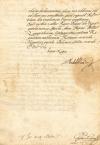 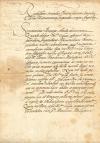 |
RUDOLF II: (1552-1612) Holy Roman Emperor 1576-1612. A good L.S., ‘Rudolphus’, two pages, folio, Prague, 25th April 1577, to ‘Dearest Princess Anita’, his own sister, in an affectionate way, in Latin. Rudolf II writes to his sister referring to their father’s early death, to the very little free time he has had since then, and states in part ‘Quanto dolore.. affecerit diui quondam Imperatoris Maximiliani, Domini genitoris nostri colendissimi augusta memoria immaturus obitus..’ further referring to the funeral homily by Tomás Marchionis Malaspina de Villafranca, saying ‘Magnifici nostri et Imperi sacri fidelis dilecti..Marchionis Malaspina de Villafranca sermone cognouimus..’. Holy Roman Emperor Maximilian II passed away in October 1576 in Regensburg at the age of 49. Countersigned at the base of the letter. Folded, with small overall age wear and staining, otherwise G £300 - 400 €340 - 450
Anna of Austria (1549-1580) Sister of Holy Roman Emperor Rudolf II. Queen of Spain 1570-80 as fourth spouse of King Philip II. Mother of future King of Spain Philip III her only child out of five to live adulthood. Anna was the eldest child of Maximilian II and was considered her father’s favourite child.
Maximilian II (1527-1576) Holy Roman Emperor 1564-76. Father of Anna of Austria and Rudolf II.
|
|

|
MARIA THERESA: (1717-1780) Holy Roman Empress as spouse of Francis I, Archduchess of Austria and Queen of Germany, Hungary, Croatia and Bohemia. She was the only female ruler and the last of the House of Habsburg. A good and lengthy A.N.S., ‘Maria Theresia’, two pages, folio, September 1766, in German. The Empress responds to her secretary at the end of a written text with a lengthy thirteen lines autograph annotation, the document referring to an inquiry received from the people of Szabatka requesting a moratorium of three months to postpone a payment due on 13th September. The Empress’ secretary advises to take away some privileges and suggests that the military pay a third or increase their military service as they also enjoy some privileges, and Maria Theresa orders and annotates in part ‘Get the commission’s opinion regarding these points, the catholic community of Szentmaria has to pay two thirds of the contribution and the remaining in three or four weeks; a resolution will have to be published properly so the involved debtors and military can decide to make this happen smoothly.’ Countersigned at the base. Small overall minor age wear, with small staining. Folded. G £200 - 300 €230 - 340
The city of Szabatka was renamed Szentamaria in 1743 after the Empress. Known today as Subotica.
|
|

|
[LOUIS XI]: (1423-1483) King of France 1461-83. Called “The Prudent” or “The Universal Spider” because of his diplomatic conspiracies. A very rare and attractive document, one page, 17 x 12 parchment, bearing an extremelly attractive and very large heavy wax seal attached, in good condition, showing the image of the King with his scepter, and text titles to the circular border, issued in Bressuire, Nouvelle-Aquitaine, 31st October 1481, in old French. The document being a pledge or guarantee given for the amount of 1200 crown écus, to Humbert de Dortans, Counselor of State to King Louis XI and his Butler since 1481. Signed ‘By the King’, by ‘Berbisey’, head of a Bourgogne family, a very attractive signature, bearing a medieval drawing alongside. Bearing a contemporary registry annotation to the verso. Folded. G £1000 - 1500 €1100 - 1700
|
|

|
HENRY II OF FRANCE: (1519-1559) King of France 1547-59. Rare D.S., Henry, one page, large oblong 20 x 11 vellum, irregularly trimmed to the right and bottom border, Villers-Cotterets, 15th March 1558, to his war Treasurer, in old French. The letter being a payment order, stating in part ‘To our dear and beloved Loys Nicolas de Caluxe, archer at the service of our dear and beloved cousin le vidasme de Chartres, knight of our order, the sum of a hundred and nine pounds..’ Countersigned by the King’s secretary Bourdin. With a contemporary signed registry annotation to the verso. Overall creasing, with right and bottom borders partially trimmed, not affecting the text or the King’s signature. F to G £500 - 800 €560 - 900
Francois de Vendome (1522-1560) is the person they referred to as vidasme de Chartres.
Henry II would die a year letter, after suffering an untimely death in a jousting tournament. Surgeons were unable to cure the infected wound inflicted by the captain of his Scottish Guard.
|
|

|
HENRY III OF FRANCE: (1551-1589) King of France 1574-89. Last French King of the House of Valois. Assassinated. A good L.S., ‘Henry’, one page, parchment, oblong folio, Paris, 12th April 1580, in old French. The document being a patent given by the King to Robert de la Vieuville, from the Comté of Rethélois, appointing him Councillor of the King’s private council. Countersigned by the Secretary of State Nicolas de Neufville de Villeroy. Folded. Overall age wear and creasing, with two very small holes not affecting the text or signature. G £400 - 600 €450 - 680
|
|

|
HENRY IV OF FRANCE: (1553-1610) King of France 1589-1610 and King of Navarre 1572-1610. First French Monarch of the House of Bourbon. Assassinated. L.S., Henry, one page, folio, Paris, 23rd August 1601, to Cardinal Visconti, in old French. Henry IV says ‘My Cousin, you will receive the visit of Sieur Bethune, on my behalf, Counselor of my State Council, who I have appointed my Ambassador in Rome..’ further stating ‘..please accept this letter, coming from a Prince who likes and esteems you a lot and who keeps in mind good remembrances.. and believe in what Sieur de Béthune will tell you on my behalf..’ With a large and bold countersignature at the base of the document. Folded with edges slightly trimmed, otherwise G £800 - 1200 €900 - 1400
The esteem King Henry IV has for his correspondent comes from few years earlier when Cardinal Visconti strongly supported King Henry IV and plaid in favour of the cancellation of his marriage with the Queen Margaret de Valois, also known as Queen Margot. In October 1599 Pope Clement VIII signed the cancellation bull and in December 1599 the Archbishop of Arles annulled the marriage. A year after King Henry IV married Marie de’ Medici, who in September 1601, only weeks before the present letter was written, gave birth to future King Louis XIII.
|
|

|
ANNE OF AUSTRIA: (1601-1666) Queen of France 1615-43 as spouse of King of France Louis XIII, and Regent of France during the minority of her son Louis XIV, 1643-51. During her regency Cardinal Mazarin served as France’s chief Minister. Anne of Austria was a Spanish Princess, daughter of King of Spain Philip III. Rare L.S., ‘Anne’, one page, folio, Paris, 6th August 1643, to Baron of Isle, in French. Less than three months before the present letter was written Louis XIII passed away, and Anne of Austria, in her capacity as Regent of France, informs her correspondent that her son The King Louis XIV, aged four, has granted Baron of Isle the patent of Senechal and of Governor of the Baron Noé. The document bears at the base a large and attractive countersignature. With few extremely small holes not affecting the signature. Very small area of paper loss, as a result of the opening of the letter where the former seal was. Small overall, minor age wear, otherwise G £600 - 900 €680 - 1000
|
|

|
[LOUIS XIII]: (1601-1643) King of France 1610-43 and King of Navarre 1610-20. L.S., ‘Louis’, by his secretary, one page, folio, Camp de D?, 27th October 1636, in old French. The cleanly written document being a pass in favour of the Ambassador appointed by the Mainz Elector, who is on his way to the Peace Congress which Pope Urban VIII convoked in October 1636 in Cologne, trying to reconcile the three crowns and bring back peace to Europe. Countersigned by Claude Bouthillier, a bold and large attractive signature. Bearing beneath the signatures a good paper seal affixed. With blank integral leaf. Folded, with small overall age wear and creasing, otherwise G £200 - 300 €230 - 340
Claude Bouthillier (1581-1652) French Statesman and Diplomat, Secretary of State and Foreign Affairs Minister 1629-32. Sieur de Fouilletourte. Richelieu employed him on many diplomatic missions trusting Bouthillier’s ability who negotiated the alliances which brought France into the Thirty Year’s War. Richelieu made him executor of his will, and King Louis XIII named him a member of the council of regency which should govern the kingdom after his death.
‘When we are involved in wars it is quite common and necessary to have to increase taxation..’
|
|
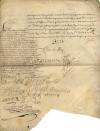 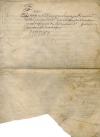 |
COLBERT JEAN BAPTISTE: (1619-1683) French Politician. Known as “Le Grand Colbert” (“The Great Colbert”) For more than twenty years Minister of Finances 1661-83 under King Louis XIV and Minister of State and of the Royal House. Colbert was an esteemed and reputed statesman who had to balance the French economy close to bankruptcy because of the King’s excessive spending. An excellent and unusual multiple L.S., ‘Colbert’, four pages, large folio, parchment, St Germain-en-Laye, 9th September 1667, to Paul Barillon d’Amoncourt and to the administrators of Mantes, in old French. The document signed by the King’s Secretary states in part ‘When we are involved in wars it is quite common and necessary to have to increase taxation..’, further saying ‘Nevertheless, we have approved such order to our finance ministry, which we expect to attend not only with our State funds, but also with the results of the war initiated in the Netherlands to protect and maintain the legitimate rights of the Queen, our dear Spouse, but not harming our subjects who, on the contrary, we want to relieve by diminishing..’ Also signed by Louis Phelypeaux and by over fifteen administrators of the finances in the “Généralité de Paris”. A letter of very interesting content signed on behalf of the King the 26th August 1667, only few weeks after the war was declared to the Kingdom of Spain. Area of paper loss to the last page, not affecting the text or signatures. Folded, with small overall age wear and small staining. G £400 - 600 €450 - 680
Louis Phelypeaux (1643-1727) Marquis of Phelypeaux and Count of Maurepas and Pontchartrain. French Politician. General-Controller of State Finances and Navy Secretary.
|
|

|
MARIA THERESA OF SPAIN: (1638-1683) Queen consort of France 1660-1683 as spouse of King Louis XIV. Maria Theresa was Infanta of Spain as daughter of King Philip IV and Archduchess of Austria. D.S., ‘Marie Terese’, one page, oblong 18.5 x 8, vellum, St-Germain en Laye, 23rd April 1680, in old French. The Queen appoints Pierre Fouré as Chief of the Queen’s pantry service and states that he will ‘..enjoy from now the honour, authority, prerogatives, notability, privileges, franchises, freedom, exemptions, rights and benefits related to his post…’ Countersigned to the left border by Edouard Colbert, a large and bold signature. Overall small age wear and creasing, folded with small tear to the bottom edge. G £250 - 350 €280 - 400
Edouard Colbert (1628-1699) Marquis of Villacerf. First butler to the Queen.
|
|

|
[LOUIS XIV OF FRANCE]: (1638-1715) Also known as Louis the Great or The Sun King. King of France 1643-1715. Son of Louis XIII. His reign of more than 72 years is the longest recorded of any monarch in European history. An excellent D.S., ‘Louis’, secretarial, one page, vellum, large oblong 25 x 18, Versailles, 26th July 1680, in old French. The King refers to the Treaties of Peace of Munster and Nijmegen, the last signed between 1678 and 1679. These Treaties ended with various wars among France, Dutch Republic, Spain, Sweden, etc.. fixing new borders, such as the north French one, close to the today’s date one. The King reminds the importance of such treaties stating in part ‘..what belongs to our Crown as a result of the Treaties of Munster and Nijmegen, We would like that no doubt remains regarding our sincere wish of maintaining the peace of the Treaties and in the Empire..’ and further orders the enforcement of the different clauses of the Treaties, stating that he will not accept any exception, and demands the implementation of the Peace of Nijmegen in the city of Frankfurt, and for such purpose appoints Romain de Sarlay, Count of Cily, stating ‘..we send a Plenipotentiary Ambassador to the city of Frankfurt, not only to grant the empire the enforcement of the clause 8 of the treaty..’ . The King wishes that Plenipotentiary Ambassadors of the different states, and his own Empire one, meet in Francfort. Countersigned to the bottom and verso by Jean Baptiste Colbert ‘Colbert’, Minister of Louis XIV, a bold and large good signature example. Folded. Very small overall minor age wear, otherwise VG £300 - 400 €340 - 450
Jean Baptiste Colbert (1619-1683) French Statesman. Minister of Finances 1661-83 under King Louis XIV
|
|

|
[LOUIS XV]: (1710-1774) King of France 1715-74. A good D.S., ‘Louis’, secretarial, one page, vellum, 13 x 10, Versailles, 1st of October 1763, to Sieur Knight de la Thyre, in French. The document being a patent given to de la Thyre, appointing him as Major of the Dijon regiment recently created in the Bourgogne Duchy. Countersigned at the base by the Duke of Choiseul. Small overall age wear and corner creasing. G £150 - 200 €170 - 230
Etienne-François de Choiseul (1719-1785) Duke of Choiseul. French Officer and Statesman. Foreign Minister of France 1758-61 & 1766-70.
|
|

|
[LOUIS XVI]: (1754-1793) King of France and Navarre 1774-1791, King of the French 1791-92. The only King of France to have been executed. Scarce D.S., Louis, signed by secretary, one page, vellum, large oblong 17 x 12 folio, Versailles, 22nd September 1788, in French. The attractive document being a Knight’s title given by the St. Louis military Order appointing Louis Charles, Viscount of Saint-Simon, Lieutenant-Colonel of the artillery regiment of La Fere. Countersigned by Louis-Marie Athanase de Loménie. Folded. In very fine condition. VG £150 - 200 €170 - 230
Louis-Marie Athanase de Lomenie (1730-1794) Count of Brienne. Minister and Lieutenant General of the armies under Louis XVI. Louis de Loménie was guillotined in Paris at the Place de la Révolution, together with four members of his family and with Elisabeth of France, the youngest sister of King Louis XVI.
|
|

|
LOUIS XVI: (1754-1793) King of France and Navarre 1774-1791, King of the French 1791-92. The only King of France to have been executed. D.S., ‘Louis’, one page, oblong 10.5 x 5.5, Rennes, 20th December 1783, in French. Louis XVI signs this order, unusually signed by the King, being a call to Louis Yves Lequeyre to declare in court as per his request. With two countersignatures. Partially repaired to the verso, overall creasing and small staining with a tear to the bottom right corner not affecting the text or signature. F to G £400 - 600 €450 - 680
|
|

|
LOUIS XVI: (1754-1793) King of France and Navarre 1774-1791, King of the French 1791-92. The only King of France to have been executed. Rare A.N., ‘Voucher for a hundred crowns to each of them’ by Louis XVI, at the base of a letter, one page, folio, n.p., 21st February 1790, in French. The document reports about a request presented by the ladies Fouquet, claiming money for an inheritance never received, and being the situation impossible to unblock legally, they suggest a provisional proposal. Written in another hand above the King’s annotation ‘We beg Your Majesty to kindly accept to give an order for this matter’. The document bears an attractive watermark. VG £400 - 600 €450 - 680
|
|

|
MARIE ANTOINETTE: (1755-1793) Last Queen of France 1774-92, as spouse of Louis XVI. Youngest daughter of Empress Maria Theresa and Holy Roman Emperor Francis I. During the French revolution she was known as “Madame Deficit” because of her lavish spending, with increasing population disliking her. Marie Antoinette was sentenced of high treason by the Revolutionary Tribunal and executed by guilloti ne at the age of 37. Rare D.S., ‘Antoinette’, beneath a two lines annotation in her hand, one page, 14.5 x 9.5, n.p., n.d., [c.1770], signed and annotated at the base of a letter addressed to her “Madame La Dauphine” by the abbot de Vermond, in French. The abbot, in the third person, states in part ‘The Abbot de Vermond takes the liberty of imploring the kindness and protection of Madame La Dauphine in favour of his brother, knight of St. Louis, Captain of the legion of Flandres..’ further reporting on his brother’s merits and services ‘..wounded and imprisoned in 1747, with his regiment almost ruined.. appointed knight of St Louis for the services rendered during the besiege of Cassel in 1761..’ and requesting ‘Sieur Vermond not wishing to dedicate his remaining days under the King’s service, asks Mr. the Duke of Choiseul to accept and agree, considering his wounds, a patent of Lieutenant Colonel granting eighteen hundred livres..’ and before concluding requests from Marie Antoinette ‘The Abbot de Vermont.. begs very humbly Madame La Dauphine to forward the request to her brother and to recommend it to Mr. The Duke of Choiseul.’ At the base of the document Marie Antoinette annotates ‘I particularly recommend this memoir to Mr. the Duke of Choiseul, Antoinette’. With a good Vanderley watermark. Folded, with an extremely small tear to the left edge, otherwise VG £5000 - 8000 €5800 - 9000
Etienne-François duke of Choiseul (1719-1785) Marquis of Stainville and 1st Duke of Choiseul. French military Officer and Statesman. French Minister of Foreign Affairs 1758-61 & 1766-70.
|
|

|
NAPOLEON I: (1769-1821) Emperor of France 1804-14, 1815. A fine L.S., ‘Napol’, (a good bold example), two pages, 4to, Paris, 17th February 1808, to the General Clarke, Minister of War, in French. Napoleon states in part ‘Order General of Brigade Razout who is in Paris to go to Orleans to join the division which is being created- The 43rd has reached Boulogne..’ further saying ‘..this battalion which did not make the Grande Armée campaign has to go via Boulogne to end reaching Le Havre..’ The text of the letter is in the hand of Meneval. Attached to the present letter and sealed to the bottom left corner a second page being an amendment annotation giving a more precise explanation regarding the battalions and regiments involved. VG £1000 - 1500 €1100 - 1700
Henri Jacques Guillaume Clarke (1765-1818) Duc de Feltre and Minister of War under Napoleon. Later Marshal of France in 1816, one of six created under King Louis XVIII from 1815-24
Claude François de Méneval (1778-1850) Baron of the Empire. Memoirist of the 19th century. Napoleon’s private secretary and his closest collaborator.
|
|

|
[LOUIS XVIII]: (1755-1824) King of France 1814-15 & 1815-24, with a brief interruption during the Hundred Days in 1815. D.S., ‘Louis’, secretarial, vellum, one page, 14 x 10 (36 x 25 cm), Paris, first of April 1817, to Alexandre de Folquier, in French. The partially printed document being the appointment of officer Folquier as Marshal of Logis of the Guards Corps. Countersigned by HENRI JACQUES GUILLAUME CLARKE (1765-1818) Marshal of France in 1816, one of six created under King Louis XVIII from 1815-24. Duc de Feltre and Minister of War under Napoleon. Signed at the base ‘M[arech]al Duc de Feltre’, beneath the printed text “Minister Secretary of State and War”. Bearing a large and attractive paper seal affixed to the front in very fine condition. VG £100 - 150 €110 - 170
|
|

|
NAPOLEON III: (1808-1873) Emperor of the French 1852-70, the nephew and heir of Napoleon I. First President of France 1848-52, therefore holding the distinction of being the first titular president and the last monarch of France. L.S., Napoleon, one page, 8vo, Palace of Fontainebleau, 23rd August 1868, to madame Masuyer, in French. The letter bears at the heading Napoleon’s blind embossed monogram. Napoleon III thanks his correspondent for her kind words and noble sentiments, and further states ‘I like finding your sentiments in your writings, they remind me a past full of loyalty..’ The written text is in the hand of Napoleon’s secretary Conti. With blank integral leaf. VG £250 - 350 €300 - 400
Valerie Masuyer (1797-1878) Last reader to Hortense de Beauharnais (1783-1837) Queen consort of Holland.
Etienne Conti (1812-1872).
|
|

|
ORSINI FELICE: (1819-1858) Italian Revlutionary. Leader of the “Carbonari” who tried to assassinate Napoleon III Emperor of the French. Orsini was sentenced to death and executed. Rare A.L.S., Felice Orsini, three pages, 8vo, 2 Church Lane, Liverpool, 27th October 1857, to Miss Finch. Orsini states ‘With very great pain I have heard that Mr. Finch is very poorly, I would call today...’ further saying ‘Today I am leaving for Birmingham and in a few days I shall be back and shall call on you and all your family. In that opportunity I hope to find Mr. Finch very much better; in every case if you think that I can be useful for something, I beg at you and your family do not spare me, because you and every person at your family have in me a friend...’. Accompanied by the original 12mo envelope in Orsini’s hand. EX £400 - 500 €450 - 560
At the time of the present letter Orsini was briefly visiting England, where he returned from Paris, to contact gunsmith Joseph Taylor and order six copies of a bomb of his own design. Orsini was convinced that with the assassination of Napoleon III, France and further Italy would rise in revolt.
Only two months later, back in Paris, Orsini and his accomplices threw three bombs at the Imperial carriage. Eight people died and over a hundred wounded, but the Emperor and Empress remained unhurt. Orsini was guillotined the 13th March 1858.
|
|

|
NAPOLEON IV: (1856-1879) Prince Imperial, the only child of Emperor Napoleon III and his Empress consort Eugenie de Montijo. Also known as Louis-Napoleon Bonaparte. Rare signed clipped piece ‘Louis-Napoleón’, a good bold ink signature example. Matted in black beneath a printed text in German “House Bonaparte”. VG £150 - 200 €170 - 230
|
|

|
NAPOLEON IV: (1856-1879) Prince Imperial, the only child of Emperor Napoleon III and his Empress consort Eugenie de Montijo. Extremely rare signed photograph, being a 2.5 x 4 visiting cabinet card. The “London Stereoscopic & Photographic Company” image depicting the young Prince seated in a formal half length pose. Signed ‘Napoleon’ in black fountain pen ink to the lower white border of the photograph, beneath the printed date 16th March 1874, on the occasion of his eighteenth birthday. Inscribed to a French officer in another hand to the verso. Prince Imperial Napoleon Bonaparte died at the very early age of 23, killed by Zulus during the Zulu War. G £400 - 600 €450 - 680
|
|

|
CHARLES II of ENGLAND: (1630-1685) King of England, Scotland & Ireland 1660-85. He succeeded his father King Charles I, executed for high treason. Charles II went into exile to mainland Europe in 1651 and remained there during the Cromwell republic until his return to be crowned in 1660. A fine L.S., ‘Carolus R[ex]’, as King in exile, at the base, one page, oblong folio, Brussels, 4th July 1657, in Latin. The King also adds alongside the text ‘Jacobus’, in his hand. The manuscript document is a request to all countries authorities, ‘Emperors, Kings, Princes, nobles, military commanders.. to permit free transit, and to help if necessary, his loyal servant 3rd Count of Castlehaven as well as his entourage..’ The King further grants his gratitude to all those who will help this officer. Bearing an attractive paper seal affixed at the base. Countersigned to the right bottom corner by Edward Nicholas. Folded. Overall age wear with two small holes to the centre folds. About G £800 - 1200 €900 - 1400
James Tuchet (1617-1684) 3rd Earl of Castlehaven. A prominent figure in the Wars of the Three Kingdoms.
Sir Edward Nicholas (1593-1669) English Secretary of State to Charles II, and previously to Charles I. Nicholas accompanied the court into exile.
|
|

|
STUART JAMES: (1688-1766) Prince of Wales, son of the deposed King James II and VII. Known as The Old Pretender. L.S., Votre affectione Cousin, Jacques R, two pages, 4to, Rome, 31st December 1743, to Cardinal Paulucci, in French. Stuart proclaims ‘I do not consider your very kind letter concerning the recent Christmas festivities as a mere expression of custom or ceremony’ and continues ‘I know the passion and sincerity of your enthusiasm for everything that concerns me, and have convincing proof of it’, further reciprocating the testimony of their friendship ‘by the truest sentiments of the heart’. Stuart has also added a lengthy postscript in his hand, in Italian, and signed with his initials G R, explaining to Paulucci that he will receive a packet of papers for the councillor, along with a letter thanking him for his of the 10th December, and remarking ‘I have nothing in particular to bother him with at the moment, and am just assuring him of my most cordial friendship. I must also add, on this the 4th January, 1744, that I have received your letter of 21st December; to which I have nothing to respond other than my sincere thanks.’ With integral address leaf bearing two red wax seals (small area of paper loss at the base where originally opened). VG. £400 - 600 €450 - 680
|
|

|
GEORGE II: (1683-1760) King of Great Britain and Ireland 1727-60. Fine D.S., George R, as King, at the head, one page, folio, Court at St. James’s, 21st March 1757. The attractively penned manuscript document is addressed to Thomas, Lord Viscount Dupplin and Thomas Potter, Paymaster General of Our Guards, Garrisons and Land Forces and authorises the payment of £20,000 to John Thomlinson and John Hanbury, merchants who ‘have represented unto us that a further sum of Twenty thousand pounds is necessary to enable them to pay several Bills drawn before the expiration of their contracts by their agents in North America to answer the demands of the Deputy Paymasters there….’ Countersigned at the foot by the Duke of Devonshire (1720-1764, British Prime Minister 1756-57), Henry Bilson-Legge (1708-1764, English Statesman, Chancellor of the Exchequer 1754-55, 1756-57 & 1757-61) and Viscount Duncannon. Also signed to the verso by both Thomlinson and Hanbury. An interesting document featuring the extremely rare signature of the Duke of Devonshire. Very slightly trimmed to the left edge and with minor overall age wear, about VG £150 - 200 €170 - 230
|
|
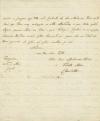 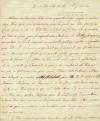 |
CHARLOTTE OF ENGLAND: (1744-1818) Charlotte of Mecklenburg-Strelitz. Queen of Great Britain and Ireland 1761-1801, and Queen of the United Kingdom 1801-18, as spouse of King George III. A good A.L.S., Charlotte, two pages, 4to, Frogmore, 12th May, 1798, to her daughter in law the Princess of Wales, in French. Queen Charlotte thanks the Princess of Wales for her interest in her daughter’s health after her difficult childbirth, and updates her on this situation stating ‘..The report given by the Stuttgart doctors says that unless some unexpected accident occurs, there is no reason to be concerned about her.’ Charlotte further refers to some letters received, saying ‘The Duke’s letters are written under strong agitation, everybody agrees on the recognition he makes for the Woman’s merits, and what pleases me even more is the attachment shown by the population to the Duchess on this occasion.’ The Queen expresses her happiness knowing that Caroline has not suffered the illness which is affecting so many of them, and hopes she will be able to visit her again soon, concluding before signing with ‘How happy I would be if I could see you here more often, and be able to prove you how much, my dear daughter, I am your affectionate and loyal Mother.’ With a partially cut blank integral leaf. Small overall minor age wear. G £400 - 600 €450 - 680
Caroline of Brunswick (1768-1821) Queen of the United Kingdom 1820-21 as the wife of King George IV. She was Princes of Wales 1795-1820.
Princess Charlotte (1766-1828) Queen of Wurttemberg as spouse of King Frederick. Daughter of King George III and Charlotte of Mecklenburg-Strelitz. The Royal couple had no children issue. On 27th April 1798 Princess Charlotte had a stillborn daughter.
Frederick I (1754-1816) Duke of Wurttemberg 1797-1816.
|
|

|
GEORGE III: (1738-1820) King of the United Kingdom 1760-1820. L.S., Madame ma Soeur, Votre bon Frere, George R, as King, one page, 4to, Court at St. James’s, 6th August 1783, to the Queen of the Two Sicilies, in French. The King informs his correspondent about the happy childbirth event of the Princess, thanking the Lord for such gift, and stating ‘The birth of a Princess…which represents an increase of my happiness..’. With integral address leaf, bearing two red wax seals with ribbons, in very fine condition. Few very small tears to the upper edge. G £300 - 400 €340 - 450
Although the letter is addressed to the Queen of the Two Sicilies, a Kingdom proclaimed in 1816, the letter is most probably written to Maria Carolina of Austria (1752-1814) Queen of Naples and Sicily, as wife of King Ferdinand IV & III. Born an Austrian Archduchess, she was daughter of Empress Maria Theresa and Emperor Francis I.
Princess Amelia of the United Kingdom (1783-1810) Youngest daughter of King George III and Queen consort Charlotte of Mecklenburg-Strelitz. She died at the early age of 27.
|
|

